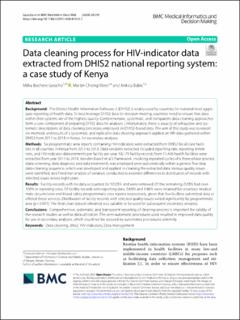| dc.description.abstract | Background
The District Health Information Software-2 (DHIS2) is widely used by countries for national-level aggregate reporting of health-data. To best leverage DHIS2 data for decision-making, countries need to ensure that data within their systems are of the highest quality. Comprehensive, systematic, and transparent data cleaning approaches form a core component of preparing DHIS2 data for analyses. Unfortunately, there is paucity of exhaustive and systematic descriptions of data cleaning processes employed on DHIS2-based data. The aim of this study was to report on methods and results of a systematic and replicable data cleaning approach applied on HIV-data gathered within DHIS2 from 2011 to 2018 in Kenya, for secondary analyses.
Methods
Six programmatic area reports containing HIV-indicators were extracted from DHIS2 for all care facilities in all counties in Kenya from 2011 to 2018. Data variables extracted included reporting rate, reporting timeliness, and HIV-indicator data elements per facility per year. 93,179 facility-records from 11,446 health facilities were extracted from year 2011 to 2018. Van den Broeck et al.’s framework, involving repeated cycles of a three-phase process (data screening, data diagnosis and data treatment), was employed semi-automatically within a generic five-step data-cleaning sequence, which was developed and applied in cleaning the extracted data. Various quality issues were identified, and Friedman analysis of variance conducted to examine differences in distribution of records with selected issues across eight years.
Results
Facility-records with no data accounted for 50.23% and were removed. Of the remaining, 0.03% had over 100% in reporting rates. Of facility-records with reporting data, 0.66% and 0.46% were retained for voluntary medical male circumcision and blood safety programmatic area reports respectively, given that few facilities submitted data or offered these services. Distribution of facility-records with selected quality issues varied significantly by programmatic area (p < 0.001). The final clean dataset obtained was suitable to be used for subsequent secondary analyses.
Conclusions
Comprehensive, systematic, and transparent reporting of cleaning-process is important for validity of the research studies as well as data utilization. The semi-automatic procedures used resulted in improved data quality for use in secondary analyses, which could not be secured by automated procedures solemnly. | en_US |

